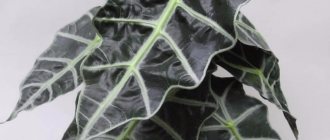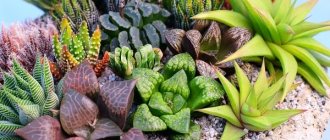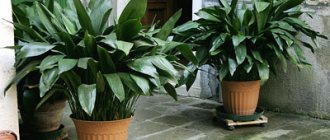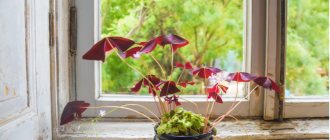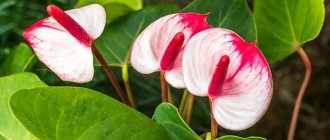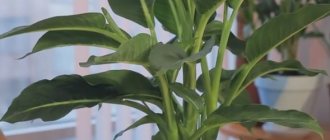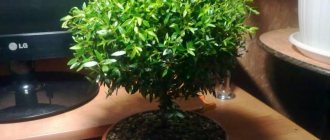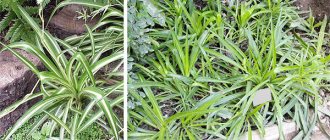The Alocasia plant is a large shrub up to 4 meters in height and 1.5 meters in width. The flower's homeland is the tropical forests of South Africa and areas of the Pacific District. This crop is distinguished by beautiful foliage and powerful thick shoots.
Alocasia leaves have a waxy surface that repels excess moisture. In addition, they secrete residual liquid that was not absorbed by the flower during feeding.
Plant characteristics
Belongs to the Araceae family, which today unites about 70 species. Alocasia is an evergreen large-leaved plant that has the following features depending on the species:
- Has a stem or stemless.
- Grows from 30-40 cm to 2 meters in height.
- The shapes of the dense leaf plates are oval, thyroid, heart-shaped, up to a meter in length.
- The root system is of the tuberous type.
Alocasia variety Black corduroy
Attention! Alocasia is a flower that contains poison; it is unacceptable for its juice to come into contact with open areas of the body and mucous membranes.
Work with the plant must be carried out in compliance with safety regulations; its placement must be inaccessible to children and pets.
In nature, after heavy tropical downpours, at home, with excessive watering, alocasia leaves begin to secrete droplets of water.
Alocasia domestica is a plant used to treat many diseases. Therapy is carried out using alcohol tinctures of certain varieties of the culture. Its magical properties have long been used in Chinese folk medicine. The phytoncides of the flower perfectly purify the air in the room.
Common varieties
Alocasia flower - indoor and outdoor plant
Professional flower growers grow various flowering varieties in greenhouses. The decorative plant looks impressive both alone and in compositions with other plants.
- Alocasia Black Velvet stands out for its unique color, reminiscent of dark green corduroy, with silvery veins on the leaves. Maximum height no more than 60 cm.
- Amazonian Alocasia (Alocasia amazonica) with pinkish-green petioles half a meter long, shield-shaped leaves up to 20 cm wide and up to 50 cm long can bloom in very rare cases. Alocasia Amazonica forms a flower about 10 cm long on a low peduncle, covered with a greenish blanket.
- Alocasia sanderiana is most often cultivated in a greenhouse. The roots are tuberous in shape, on brownish-green petioles 25-50 cm long, there are green arrow-shaped leaves 40 cm long and up to 15 cm wide. A striking representative of this dwarf variety - Alocasia Bambino - is distinguished by narrow elongated spear-shaped leaves, its flowers are white and purple.
- Large-rooted alocasia (Alocasia macrorrhizos - macrorhizos), or Indian or Arma (Alocasia indica), the trunk height reaches 2-3 meters, the length of the petioles is a meter, it has heart-shaped leaf plates up to a meter long and almost the same width. The peduncle is up to 30 cm long, where the spadix is covered with a greenish-yellow blanket, inconspicuous and fragrant. Alocasia macrorhizomatous is also used as a medicinal plant.
- Alocasia odora has linear-ovate petiolate leaf plates up to 70 cm wide, up to a meter long, divided at the base. The flowers have a specific smell. The plant has healing properties - Chinese healers use the indoor flower for stomach and toothache, pneumonia and tuberculosis. But it is not recommended to treat yourself in this way.
- Alocasia Calidora has large, wrinkled leaves. This hybrid form, obtained by crossing the varieties of fragrant and gageana, reaches a growth of more than 2 meters in height. The foliage is dense, thick, about a meter long.
- Alocasia polly (polly) is a low plant (up to 70 cm) with a short stem, dark shield-shaped foliage up to half a meter long, up to 20 cm wide. The foliage has whitish veins, has a metallic tint, jagged edges and ends. Alocasia polly, if care at home is optimal, can bloom much more often than other varieties.
- Alocasia lauterbachiana was discovered by the German naturalist Karl Lauterbach in New Guinea. It has strongly elongated, notched leaves of a dark green color, with a burgundy tint on the back side. The cuttings and inflorescences of the variety are distinguished by the same shade. Alocasia Lauterbachiana grows up to 70 cm.
- Alocasia Dragon is low, with light green, heart-shaped leaves and dark veins on them.
Many species are quite difficult to acquire for home breeding, some of them are not cheap - Cuculata, Corazon, Sarian, Kupreya - from several hundred to several thousand rubles.
General information
The description of the flower includes many varieties and hybrids, but the main one grown as a houseplant is “Polly” or “Amazon” (A. amazonica).
Photos of Alocasia are impressive with stunning leaves that are shaped like an arrowhead or shield with large prominent white veins running through them, which contrasts greatly with the rest of the dark green leaf.
Features of home care
The tropical culture Alocasia prefers care at home that is as close to natural as possible.
- Lighting
Alocasia - home care, description of Polly and Amazon varieties
Bright, but diffuse for variegated species, slightly darkened for green-leaved species. Window sills facing west and east are optimal; if the windows are south, the plant needs to be shaded.
Reference! Variegated varieties require more light. With a lack of light, the foliage loses its spectacular color.
- Watering
During the growing season, water abundantly with soft, settled water, but only after the top layer of soil has dried. In the autumn period there is a gradual reduction and during the dormant period - moistening 1-2 days after the soil surface has dried out.
- Room temperature and humidity
In the spring-summer period 20-27 degrees, in winter - 18-20. Elimination of drafts and sudden temperature changes.
High air humidity, systematic soil moistening by wiping and spraying. On very hot days, you can put moistened pebbles or expanded clay in the tray.
- Soil and fertilizing
During the growing season (spring-summer-autumn), fertilize with complex mineral fertilizers for decorative leafy crops and organic matter every 2-3 weeks. It is important not to overdo it; fertilizers need to be diluted, reducing the concentration by 2-3 times.
The soil mixture should consist of coniferous, leaf and peat soil and sand (coconut shavings, sphagnum - for aeration, soil permeability), add a handful of charcoal. Acidity - weak pH 5.5.
The plant requires almost no pruning. Dead dried leaves are removed with pruning shears until healthy tissue is removed, and the cut site is treated with charcoal.
Note! Both drying out of the soil in the pot and overwatering are unacceptable. After 15 minutes, excess water is drained from the pan.
Features of care during the rest period
It starts in mid-autumn (October) and ends in early spring (late February - early March). In autumn, yellowed leaves should be removed, the plant should be removed from the windowsill to a moderately lit place, and watering should be gradually reduced.
The temperature for the winter should be about 20 degrees. In spring, normal care is gradually resumed.
There are varieties that do not go into complete dormancy and continue to grow at incomplete strength. Therefore, in winter, it is possible to continue fertilizing and watering the plant, occasionally and in very small doses.
Reviews about growing
Advantages: very beautiful ornamental plant.
Disadvantages: poisonous. I’ve been wanting to buy Alocasia for a long time, but then my husband brought me a shoot from work. Of course, I was pleased and planted it in a beautiful pot. It hasn't grown at all for a very long time, only now, in the spring, it started. What attracts me most about it is the unusual shape and decorative dark green color of the leaves, with bright white veins. This is what I have, and there are also ones with red or purple veins. Of course, since the plant is very poisonous, it should be kept away from children. Alocasia should be watered quite often as the soil dries out, and fertilized during the period of active growth. I fertilize once a month with complex fertilizer. helen-vay
https://otzovik.com/review_933443.html
Pros: handsome!
Disadvantages: capricious, does not take root well in our conditions. Oh, this Alocasia Polly. I bought it in winter. I replanted it in new soil for alocasia, added vermiculite, and finely chopped sphagnum. Added drainage to the bottom. Just a couple of days later, yellow spots appeared on the leaves, then the leaves themselves began to turn yellow. I dug it up and discovered that the bulb and roots had begun to rot. No matter how I tried to revive the bulb, nothing worked. Later I read that alocasia is very prone to rotting bulbs, you need to be careful with watering. Tim82
https://irecommend.ru/content/alokaziya-polli
Alocasia was given to me for my birthday at work.
There were 2 leaves))) Now the beauty has grown, she even wants to bloom! I don’t make any special efforts to grow it, I just don’t put it in the sun and try not to overwater it. Tatiyanna77
https://irecommend.ru/users/tatiyanna77
How does alocasia bloom?
Aphelandra flower - home care
Flowering occurs in spring, and in very rare cases:
- possible only in mature alocasia (4-5 years);
- when creating the most suitable microclimate indoors at home;
- If you briefly dry out the earthen ball from the beginning of spring, this will trigger the mechanism of setting a flower bud.
Flowering of different types of alocasia
The inflorescence is a white, cream-colored spadix, surrounded by a veil, located on a dense, shortened stalk. Bright red fruits ripen on it. During the flowering period, the foliage slows down and partially falls off.
Reference! Since the flower is not very attractive, and the aroma of some varieties is unpleasant, many gardeners get rid of the inflorescence from the very beginning of its formation. After all, foliage is the main decoration of alocasia. During the flowering period, its toxic properties are activated.
Optimal time for planting
Alocasia should be planted in permanent soil immediately after purchasing it in a store.
You need to plant alocasia in a pot like this:
- The roots of the plant must be cleaned of soil and carefully inspected, identifying those that are dried out and rotten. The latter need to be removed.
- Alocasia roots need to be washed from the substrate and soaked for half an hour in a nutrient solution to improve the adaptive process of the plant.
- Now the flower needs to be placed in a previously prepared pot and filled with new soil. The root collar remains half-open, located at the very border of the soil.
The ideal time for planting alocasia is considered to be spring, when the plant enters the active growth phase. During the summer, the plant will have time to settle into its new location and will survive the winter well. However, if the plant was purchased in the autumn-winter period, it can and should also be planted in a pot. Only the adaptive period in this case takes a little longer.
How does alocasia reproduce?
There are several methods of propagation - stem cuttings, rhizome division, daughter tubers, seeds.
Seed propagation is an inconvenient method because:
- seeds lose their viability extremely quickly;
- varietal characteristics (variegated foliage color) are not preserved with this method.
The seeds are distributed over the surface of the soil mixture consisting of peat and sand, slightly pressing, covered with film (glass) and put in a warm place (22-24 degrees). Ventilate regularly to get rid of condensation and moisten the soil. After the seedlings appear and grow stronger and acquire 2-3 leaves, they are planted in separate pots with a diameter of 7 cm. After a year, they are transplanted into a pot with soil for an adult plant.
Sometimes alocasia is divided by planting tubers during transplantation. First, the roots are soaked in water, freed from the ground, and the plant is divided into parts with a sharp knife, carefully separated from the mother bush, then germinated in sphagnum at a temperature of 23 degrees.
Reproduction by separation from the mother
When dividing the rhizome and preparing cuttings from the stems, the cut site or rhizome should be treated with crushed charcoal and left for 2-3 hours. Then plant the seedling (cutting) in a substrate of peat and sand, cover it with film (glass), place it at a temperature of 22-24 degrees, regularly ventilate and water it.
For reference! After 2-4 weeks, the young plant is ready to grow large leaves. With the appearance of roots and first sprouts, the flower is transplanted into a permanent pot.
Bloom
In indoor conditions, alocasia blooms quite rarely, so when grown artificially, the plant is considered an ornamental deciduous plant. Indoor alocasia can bloom only 7 years after planting. The petiole is usually slightly longer than the peduncle.
Alocasia spends a lot of effort on forming flowers, so after flowering it loses its decorative qualities. During this period, the leaves fall off and the plant takes a long time to regenerate. To restore the decorative value of a flower, you need to properly care for it. When alocasia fades, you need to place the pot in a cool place.
To stimulate flowering in winter, it is necessary to stop watering for a short time. “Drying” will push the alocasia to flower.
Alocasia transplant
At a young age, the crop is replanted annually, an adult plant - every 2-3 years. The most favorable period for this is spring.
The pot is chosen deep, 2 cm larger than the old one. Drainage is laid at its bottom, then soil consisting of leaf, peat, coniferous soil and sand. Another option is turf, humus, leaf soil, sand and peat. A handful of charcoal in the soil will save the roots from retaining excess water.
Transplantation by transshipment method
The largest specimens are replanted using the transshipment method - the plant is pulled out of the old pot with a ball of earth, placed in a new pot for drainage and sprinkled on all sides with new soil.
Possible difficulties
When growing alocasia, you should pay attention to the following difficulties that gardeners usually encounter when growing this plant:
- Alocasia has stopped growing. This situation arises for two reasons: either the plant needs replanting or is experiencing a deficiency of minerals. The solution here is very simple; the flower needs to be transplanted into a larger pot or, if the container is normal for the plant, fed.
Alocasia diseases - Alocasia leaves wither. This problem occurs when the soil is excessively waterlogged. It can also occur when the earthen lump is very dry. In this case, it is enough to adjust the watering. If, even after normal watering, the leaves continue to wither, it means that the soil in the pot is too dense. In this case, you should change the soil to a looser and more breathable one.
- Alocasia leaves have turned pale or changed color. This situation occurs with aging and dying leaves. In place of the old fallen leaves, after a certain period of time, new leaves grow. The drawing on the sheet may fade due to lack of light.
- The tips of the leaves dry out and turn black. The reason is lack of watering, low light, low air humidity.
- Dark spots have appeared on the leaves of Alocasia. There may be several reasons: drafts, hypothermia, too dry or vice versa, damp soil, overdose of fertilizers. Dark spots sometimes appear due to mechanical damage, waterlogging of the soil and excessive application of nitrogen fertilizers. This situation often leads to the occurrence of fungal and bacterial rot. In this case, the rotten place is treated with fungicides or the plant is transplanted into new soil.
- Rotting of the rhizome. This problem occurs when the room temperature is low, there are drafts, and the plant is flooded so that the soil does not have time to dry.
Pests and diseases
Weakened by excessively dry air and high temperatures, alocasia, the proper care of which has not been properly cared for, can be colonized by scale insects, spider mites, aphids, and mealybugs. First wipe the leaves and stems with a soapy sponge; if that doesn’t help, use Actellik solution (1-2 ml per liter of water).
Pests on Alocasia
Diseases associated with violations of detention conditions:
- Slow growth during the growing season indicates a lack of nitrogen.
- Wilting of foliage can be associated with both a lack of moisture and waterlogging of the soil. It is necessary to optimize watering and the composition of the soil mixture so that the moisture does not stagnate. If the leaves turn yellow and fall off one by one, this is a normal renewal process.
- Drying of the tips of the leaves indicates a low level of air humidity and poor watering.
- Faded foliage indicates a lack of light.
- The formation of dark spots on the foliage due to sudden changes in temperature.
- Brown spots on the leaves are signs of flower hypothermia.
Despite the attractiveness and diversity of species, alocasia is currently only gaining popularity in home breeding. This exotic miracle, a magnificent deciduous and ornamental plant, looks worthy in bright halls and foyers, in winter gardens, near fountains and ponds. Caring for a plant, according to most gardeners, is easy and interesting.
Top dressing
Proper feeding activates rapid growth and beautiful flowering for a long time. For alocasia, mineral complex compositions based on potassium-phosphorus mixtures are used.
It is necessary to feed the flower in early spring or late autumn before hibernation. Fertilizers are diluted in a proportion of 10 g per 1 liter of warm water. The liquid is thoroughly mixed and watered or sprayed.
